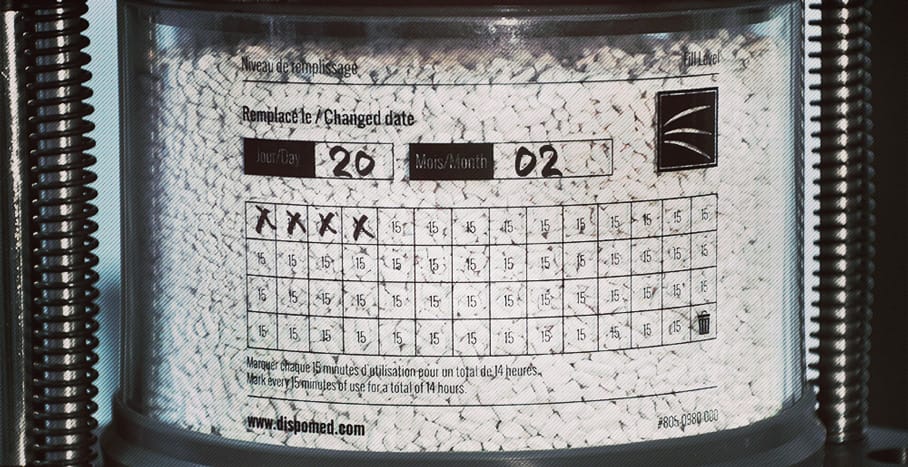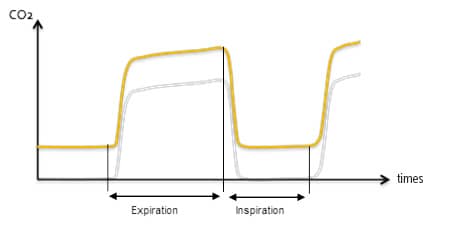
Introduction
Soda lime is responsible for the elimination of carbon dioxide (CO2) in rebreathing circuits. When exhausted, CO2 accumulates in the circuit and is rebreathed by the patient, causing respiratory acidosis that can be harmful.
Key points: methods to know when to change soda lime:
- Increased inspired CO2 (detected by capnography)
- Color change
- Lack of heat in the canister
- Clinical signs
- Hardness of granules
- Time in function
Measuring inspired CO2
Measuring inspired CO2 is the most reliable method to detect absorbent exhaustion. This can be done with a capnograph. A typical waveform obtained during CO2 reinspiration caused by soda lime exhaustion is illustrated in Figure 1. During inspiration, the patient breathes CO2: the curve does not return to 0 during inspiration. The shape of the trace is normal, and the end-tidal CO2 value is increased.

Figure 1: Typical capnograph waveform obtained when soda lime is exhausted (yellow), compared to a normal waveform (grey). During inspiration, the curve does not return to 0, but the shape of the waveform is normal. End-tidal CO2 value is increased.
Indicator color change
When CO2 reacts with soda lime, heat and water are formed, and pH changes. The latter causes the indicator contained in soda lime to change color (typically from white to pink), indicating that the absorbent is near the point of exhaustion.
Absorbent should be changed when 2/3 of the canister has changed color. Keep in mind that the color may revert back to its pre-exhaustion color when not in use. Upon reuse, the indicator color will rapidly return to it’s exhausted state. Therefore, a rested canister can give a false sense of security. For this reason, inspection of the absorbent color should be made during or just after anesthesia.
Additionally, if the absorbent is not packed properly in the canister, channeling can occur: the airflow passes through a channel in the soda lime, exposing only a small part of the absorbent to CO2. As absorbent along the channel becomes exhausted quickly, the patient rebreathes CO2. The rest of the soda lime remains white, giving a false sense of security. Figure 2 illustrates those patterns of absorption.
Therefore, indicator color change is useful but is not reliable.

Figure 2: Pattern of CO2 absorption in the canister. Purple circles represent exhausted soda lime; white circles represent fresh soda lime.
- A) Unused canister, or appearance of the canister after some time unused: all granules are white.
- B) After limited use: absorption of CO2 has occurred primarily at the inlet and to a lesser extent along the sides.
- C) After extensive use: the canister appears nearly completely purple as granules on the side are exhausted.
- D) Exhausted soda lime: CO2 is filtering through the canister; the only granules that are still capable of absorbing CO2 are in the distal third.
- E) Channeling effect: air passes through the soda lime preferentially through a channel. Soda lime, in this channel, is quickly exhausted, and the patient breathes CO2 even though the canister remains white if the channel is not along the wall.
Related Products we Have for You!
Other signs
As stated above, during CO2 absorption, heat and water are formed. Therefore, during anesthesia, the canister should be slightly warm to the touch and water droplets should be visible on its wall. The amount of heat and water vapor is proportional to the amount of absorbed CO2. If a high oxygen flow is used (100 ml/kg/min), CO2 is not eliminated from the circuit by the soda lime. In this situation, the canister could remain cold. However, if the canister remains cold with an appropriate oxygen flow (20 ml/kg/min on a standard rebreathing circuit), it is imperative to check for other signs of soda lime exhaustion.
When a patient breathes CO2, clinical signs may include: increased respiratory rate, increased amplitude of respiratory movement, increase sympathetic tone (increased heart rate and blood pressure), vasodilation, and red mucous membrane. A blood gas analysis will reveal a respiratory acidosis. Without a capnograph, if those clinical signs are seen, it is important to consider soda lime exhaustion in the list of differential diagnosis.
The aspect of the granules can also be used as an indicator. Granules should fragment easily. If this is not the case, it suggests that soda lime may be exhausted. It is particularly important when changing soda lime. If the hardness of the soda lime is different compared to usual, it may suggest it is already exhausted.
Without a capnograph, even if the color of the soda lime does not change, it is recommended to change the absorbent after a given amount of time. For a standard anesthesia machine, Dispomed recommends changing the soda lime after 14 hours of use. However, keep in mind that soda lime may be exhausted faster than in 14 hours and that you may have to change it more often than every 14 hours.
Finally, if there is dust in the canister or if the canister is cracked or not filled, soda lime should be changed.
Conclusion
Soda lime is a key element in a rebreathing circuit. As with most anesthesia equipment, inappropriate use can be harmful, or even lethal, for the patient. Capnography is the only way to make sure the soda lime is functional. The other methods only suggest that the soda lime needs to be changed, but they are not reliable. It is therefore imperative to consider all those methods when using soda lime.
Finally, it is best to change soda lime before the patient inspires CO2. Changing soda lime during anesthesia requires changing the circuit, delaying the procedures, and exposing the patient to anesthesia for a longer time. The time needed to do all of this will not be dedicated to monitoring the patient, which may increase anesthesia risk. Additionally, as most indicators appear when soda lime is already exhausted, the patient would already suffers from the consequences of rebreathing CO2.








